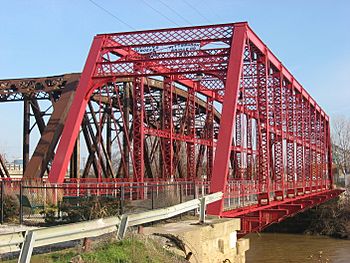Pigeon Creek (Indiana) facts for kids
Quick facts for kids Pigeon Creek |
|
|---|---|

The Ohio Street Bridge over Pigeon Creek where it empties into the Ohio River at Evansville, Indiana
|
|
| Country | US |
| State | Indiana |
| Physical characteristics | |
| Main source | Indiana, US |
| River mouth | Evansville, Indiana, US |
| Length | 76.4 km (47.5 mi) |
| Basin features | |
| Basin size | 836 km2 (323 sq mi) |
Pigeon Creek is a stream in southwestern Indiana, US. It is a tributary of the Ohio River. This means it's a smaller stream that flows into a larger river.
Pigeon Creek is about 47.5 miles (76.4 km) (76.4 km) long. It starts in two places: one in Gibson County near Princeton, and another near Owensville. These two parts join together southeast of Fort Branch.
Contents
The Journey of Pigeon Creek
From where its two parts meet, Pigeon Creek flows southeast. It goes under Interstate 69 and heads towards Warrick County. Near Lynnville, it turns south. Here, it flows under Interstate 64. Interestingly, at this point, signs might call it the "Wabash and Erie Canal" instead of Pigeon Creek.
Growing Bigger
As Pigeon Creek continues its journey, it gets bigger. Two other streams, Little Bluegrass Creek and Big Bluegrass Creek, flow into it in western Warrick County. After this, the creek turns west. It crosses into Vanderburgh County. This crossing is just north of Evansville's East Side.
Flowing Through Evansville
Pigeon Creek then flows west through the East and North Sides of Evansville. More small streams join it along the way. Finally, it turns south, flowing between Downtown Evansville and Westside Evansville. This is where it empties into the mighty Ohio River.
The Pigeon Creek Watershed
A watershed is an area of land where all the water drains into a single river or stream. The Pigeon Creek watershed covers a huge area of 235,000 acres. This means Pigeon Creek carries almost all the rainwater that falls on 323 square miles (840 km2) (836 km²) of land around it.
Land Use in the Watershed
The land in the Pigeon Creek watershed is used for different things:
- About 48% of the land is used for farming.
- Around 5% is covered by cities and towns.
- About 7.5% of the land is wetlands, which are important natural areas.
- The remaining 21% is covered by forests, with about 50,000 acres of woodlands.
History of Pigeon Creek
Pigeon Creek has an interesting history. In the past, many businesses and factories were built along its banks. One example was a textile mill, which made cloth. This mill was closed down in the early 1900s.
The Wabash & Erie Canal
In the 1800s, Pigeon Creek was an important part of the Wabash and Erie Canal. This canal was a waterway built to transport goods. It allowed flatboats to travel from the canal directly to the Ohio River near the mouth of Pigeon Creek.
Building the canal changed the creek's natural path quite a bit. Farmers also changed many of the small streams that feed into the creek. However, the canal stopped following Pigeon Creek where the creek's path changes from south to west in Warrick County. This left much of the creek's path undeveloped, which is unusual for a stream in a city.
Wildlife and Recreation
Even though it flows through a busy city, Pigeon Creek is like a natural haven for wildlife. It provides homes for many different kinds of fish, waterfowl (birds that live near water), and mammals.
The Pigeon Creek Greenway Passage is a popular trail along the creek and the Ohio Riverfront. People use this trail for walking, jogging, and biking. It's a great way to enjoy nature right in the city!

